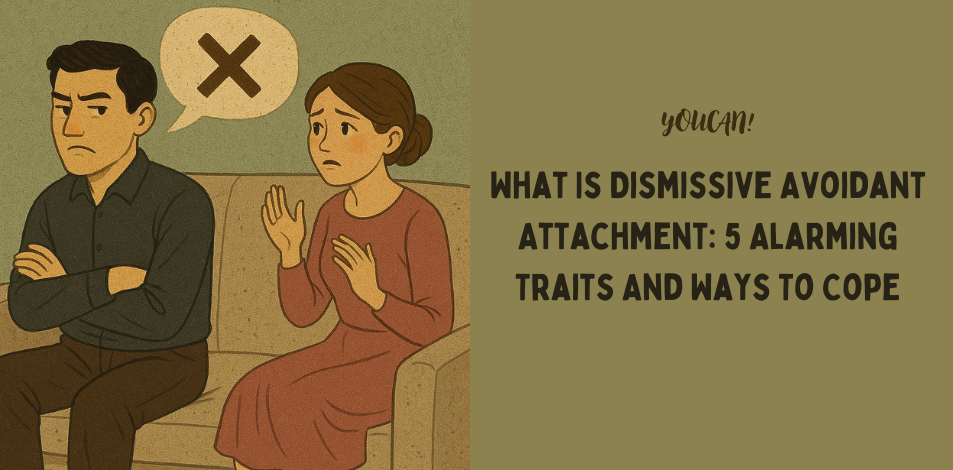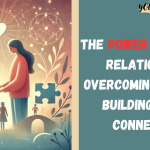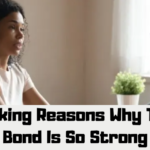
Do you or someone you care about find it difficult to express your feelings and build close relationships with others? Despite your best efforts, you seem to be sabotaging yourself in relationships. If these scenarios sound familiar, you may be suffering from what is known as dismissive-avoidant attachment.
This pattern often begins in early childhood and is uncontrollable. Individuals with a dismissive-avoidant attachment style may not fully understand why they face challenges in relationships or tend to shy away from intimacy.
The good news is that there are ways to cope with and overcome these difficulties. In this article, we will delve into the dynamics of dismissive-avoidant attachment and offer insights and strategies to help overcome these difficulties.
What Is Dismissive-Avoidant Attachment?
Dismissive-Avoidant Attachment is a concept within attachment theory that describes individuals who prioritize independence and self-reliance, often at the expense of close relationships.
What Is Dismissive-Avoidant Attachment? People with a dismissive-avoidant attachment style often have difficulty feeling and expressing their emotions, which can lead them to appear withdrawn or emotionally unresponsive.
Related : How to Make a Narcissist Fear You? 12 Greatest Fears of the Narcissist
They may not respond effectively when their partner shares their vulnerable feelings, adopting an attitude that views emotional expression as unhelpful. Their approach to dealing with conflict tends to be avoidant, as they are uncomfortable with strong emotional expression, and they may lack the confidence to resolve relationship conflicts. Dismissive-avoidant attachment can lead to significant challenges in building and maintaining intimate relationships.
It’s important to recognize that these behaviors and attitudes are often rooted in an individual’s attachment history and coping mechanisms that have developed over time. Creating a safe space for them to share feelings and respecting their need for this space are important steps in maintaining a healthy relationship!
5 Traits of a Dismissive-Avoidant Attachment Style You Should Know!
Relationship experts have described the dismissive-avoidant attachment style as a preference for independence and self-reliance, often at the expense of close personal relationships.
What is dismissive-avoidant attachment? Here are some key characteristics of the dismissive-avoidant attachment style you should know:
- Displaying Restricted Emotions
People with a dismissive-avoidant attachment style often have difficulty expressing and processing their emotions. They may adopt attitudes that dismiss or downplay feelings, viewing them as unproductive or unnecessary.
This can lead to a tendency to suppress emotions, especially in stressful situations, and a general avoidance of conflict in relationships.
- Downplaying the Importance of Relationships
Dismissive-avoidant people may downplay the importance of their relationships. For example, they may be reluctant to share photos of their partner or feel uncomfortable displaying affection publicly on social media. They often prioritize other aspects of their lives, such as work or hobbies, over their romantic relationships, which can make their partners feel unappreciated.
- Difficulty Dealing with Commitment
Maintaining independence and autonomy is crucial for those with dismissive-avoidant attachment. They may have a history of leaving relationships, or they may periodically withdraw from their partner, expressing uncertainty about their feelings or wanting to see other people. This behavior can make their partners feel unwanted or rejected.
- Maintaining Distance
People with this attachment style are often protective of their time and may be critical of their partners.
They may feel overwhelmed by requests to spend more time together, and they may limit affection or cancel plans if they feel the relationship is getting too close. Their partners may feel deprived by this avoidant approach.
- Lack of Direct Communication
Sending clear messages about one’s feelings requires a certain level of emotional awareness, which dismissive avoidant people often lack. As a result, their communication may be vague or unsatisfying, leaving them confused or feeling unwanted by their partners. But doesn’t this sound a bit narcissistic?
Related : Why The Hoovering Narcissist Won’t Leave You Alone
Well, this couldn’t be further from the truth. Although the dismissive-avoidant personality type exhibits signs of a narcissistic personality type, the causal relationships between them are completely different! Let’s take a closer look at the differences!
Avoidant_Avoidant_Personality and #Narcissistic_Personality – What’s the Difference?
In relationships, both narcissists and narcissists may struggle to express their feelings, avoid discussing their feelings, and withdraw during times of conflict.
What is avoidant-avoidant attachment? However, their underlying motivations differ.
Avoidant narcissists do this because they feel uncomfortable with intimacy and emotional intensity, while narcissists focus on their own needs and desires, often at the expense of others.
The key difference lies in empathy and self-awareness. Someone with avoidant-avoidant attachment may be aware of their difficulties and not intend to harm others.
They may even seek therapy to address their issues. In contrast, narcissists rarely admit to their mistakes and are less likely to seek help or change their behavior.
This avoidant-dismissive personality type often stems from childhood experiences, such as neglectful parenting, unmet needs, or previous abusive relationships. It can also be influenced by genetic factors. In relationships, this can manifest as avoidance of emotional intimacy and a tendency to maintain a self-sufficient and independent approach.
Dismissive Avoidant Attachment Style In Relationships: What Does It Look Like?
Some people with a dismissive-avoidant attachment style tend to be independent and do things on their own. They often appear withdrawn or unfriendly.
They have difficulty getting close to others and sharing their feelings. What is dismissive-avoidant attachment? If you’re in a relationship with someone with a dismissive-avoidant attachment style, you may feel lonely, frustrated, or unappreciated.
It’s difficult to talk about feelings with them because they may withdraw or shut down when things get intense. The closer you get to them, the more distant they may act, especially if they have a dismissive-avoidant attachment style in relationships.
They find it difficult to share deep feelings and may even consider breaking up. Although they act this way to protect themselves from excessive emotional involvement, it can leave them feeling lonely in the long run.
Related : Why Do Narcissists Come Back to Old Relationships?
Sometimes, seeking therapy together or individually can help address these issues and improve the relationship. If you’re struggling with avoidant attachment in your relationships, we have some tips for you.
10 Tips for Dealing with Avoidant-Dismissive Attachment
Dealing with a dismissive-avoidant attachment style in a relationship can be challenging, but some strategies can help manage relationship dynamics and improve communication. What is avoidant-dismissive attachment?
Here are some key ways to deal with avoidant-dismissive attachment:
- Understand the attachment style:
It’s important to recognize that a dismissive-avoidant partner may struggle to feel emotionally close, trust others, and rely on others in relationships. They often maintain distance and may withdraw when they feel stressed or overwhelmed by intimacy.
Understanding that your partner’s actions don’t necessarily reflect their feelings toward you, but rather their way of coping, can help you better manage the relationship.
Acknowledging their struggles with emotional openness and dependency can help you handle interactions with compassion and patience. When your partner withdraws or sets boundaries, it’s important to respect their need for space and independence. Pushing them to open up or be more emotionally available can increase their discomfort and distance.
- Communication Tips:
Avoid chasing them when they withdraw; instead, give them space and welcome them warmly when they return. You can use these tips to improve communication: Use a gentle communication style, avoid criticism, and express your needs positively.
Be aware of the narratives you form about your partner, and try to view their actions from a curious and non-judgmental perspective. Exercise self-control before expressing your feelings, as strong emotional expressions can be stressful for them.
- Avoid Guilt:
Guilt can sometimes make matters worse for avoidant partners. It can reduce their desire to change. Avoidant partners don’t like feeling pressured or guilty, so when they feel this way, they may withdraw even more.
Instead of motivating them to improve, guilt can make them defensive. They may see it as a way to control them, pushing them away and making them less willing to talk about their problems.
- Learn Patience:
Changing attachment styles takes time and effort. Being patient and understanding that your partner’s behavior stems from coping strategies they’ve learned over time can help maintain a supportive environment.
Recognizing that these coping strategies are habits formed over the years can help you handle any changes with grace and compassion. It’s important to give your partner the time and space they need to process their feelings.
- Don’t Rush Into Intimacy:
A characteristic of a dismissive-avoidant attachment style is an inability to open up to their partners. Instead of overwhelming them with desires and fears, it’s better to be patient and compassionate.
Acknowledge their efforts in sharing their feelings and create a safe environment where they feel comfortable expressing themselves more. Enjoying the closeness that comes with their openness without forcing it can help them gradually become accustomed to intimacy at their own pace.
Related : How Do Empaths Protect Themselves From Narcissists?
This includes having meaningful conversations, spending quality time together, and showing genuine interest and affection without pressuring them to share more than they are comfortable with.
- Set a clear course for conversations:
In any relationship, it’s important to communicate clearly, especially when discussing sensitive topics.
Before engaging in these conversations, it’s helpful to explain why you want to talk about it. This will help your partner feel more comfortable and prepared to participate in the discussion.
For example, take some time to tell your partner that you want to discuss the issue openly and respectfully. You could say that your goal is to ensure that both of you feel heard and understood, and that you aim to strengthen your relationship by working together to resolve difficult issues.
- Focus on your mental health:
Maintaining your mental health is crucial. It’s essential to ensure you’re taking care of yourself and meeting your own needs. One way to do this is by doing things you enjoy and seeking support from friends and family.
Participating in activities that make you feel good, such as hobbies or relaxation techniques, can help you feel better overall. Reaching out to people you trust for help or even just to talk to them can provide comfort and encouragement during difficult times. Remember, it’s okay to take care of yourself and ask for support when needed. This way, you can manage stress, improve your mood, and maintain a healthy balance in your life.
- Appreciate efforts and progress:
It’s important to recognize and appreciate the steps your avoidant partner takes toward closeness and vulnerability, even if they seem small. By acknowledging these efforts, you can encourage positive behavior and strengthen your bond.
For example, if your partner shares a personal experience or feeling, take a moment to express gratitude and validation. Tell them that you appreciate their openness and trust. Even if this gesture seems small, it’s important to make it clear that their efforts are cared for and appreciated.
- Use “I” statements to avoid criticism:
Phrase your concerns as “I” statements to avoid making your partner feel criticized or attacked. Pay attention to how your attachment style interacts with their partner’s attachment style and adjust your approach accordingly. Providing practical help may be more effective than emotional support for someone with an avoidant attachment style.
- Professional Support:
Consider psychotherapy for both partners to address the complexities of the relationship and address attachment concerns. Couples therapy can provide a safe space for the person with avoidant attachment to open up.
Understanding the nuances of what’s called a dismissive-avoidant attachment style and adapting your approach to it is key to getting your partner to open up.
You can build a more fulfilling and harmonious relationship. Remember, it’s important to balance your partner’s need for space and independence with the emotional closeness and intimacy necessary for a relationship.
Conclusion
Dealing with dismissive-avoidant attachment in relationships can be challenging. These people value their independence, and expressing their feelings is difficult for them. This behavior often begins in childhood and is uncontrollable. But here’s the good news! We can find ways to improve things.
This article discusses what avoidant-avoidant attachment is, its characteristics, and how it differs from narcissism. If you or someone you know struggles with avoidant-avoidant attachment, there is help available.
Understanding your partner’s struggles, being patient, and finding a good balance between giving them space and emotional closeness can make a big difference. Remember, it’s okay to seek professional help if things get difficult.
By working together and providing support, people can build happier, healthier relationships and find the right balance of independence and emotional closeness.




